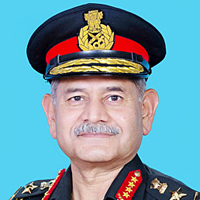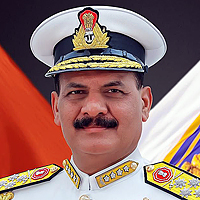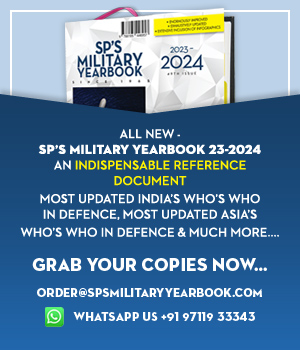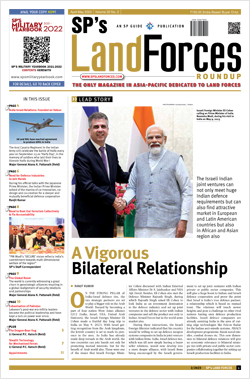INDIAN ARMED FORCES CHIEFS ON OUR RELENTLESS AND FOCUSED PUBLISHING EFFORTS

The insightful articles, inspiring narrations and analytical perspectives presented by the Editorial Team, establish an alluring connect with the reader. My compliments and best wishes to SP Guide Publications.

"Over the past 60 years, the growth of SP Guide Publications has mirrored the rising stature of Indian Navy. Its well-researched and informative magazines on Defence and Aerospace sector have served to shape an educated opinion of our military personnel, policy makers and the public alike. I wish SP's Publication team continued success, fair winds and following seas in all future endeavour!"

Since, its inception in 1964, SP Guide Publications has consistently demonstrated commitment to high-quality journalism in the aerospace and defence sectors, earning a well-deserved reputation as Asia's largest media house in this domain. I wish SP Guide Publications continued success in its pursuit of excellence.
- Appointments Committee of Cabinet approves one-month extension in service of Chief of the Army Staff
- Prime Minister witnesses 'Bharat Shakti' – a Tri-Services Firing and Manoeuvre Exercise in Pokhran, Rajasthan
- Interim Defence Budget 2024-25 — An Analysis
- Union Defence budget 2024
- Indian Army: In quest of greater firepower and policy recommendations for gaps
- Indian Army Annual Press Conference 2024
- Tata Boeing Aerospace Delivers 250 AH-64 Apache Fuselages, Manufactured in India
‘Efforts are on to design and develop indigenously as also acquire transfer of technology’

Lt General J.P. Singh is the Deputy Chief of Army Staff (Planning & Systems) and is responsible for equipping and developing the capability of the Indian Army. In an exclusive interview to SP’s Land Forces, General Singh spoke on various aspects of the procurement procedure of new weapons and defence systems.
SP’s Land Forces (SP’s): How has your tenure in the Integrated Defence Staff helped you in comprehending the problems in the assignments of DCOAS (P&S)?
Lt General J.P. Singh: As the Deputy Chief of Integrated Defence Staff (IDS), I was heading the Policy Planning & Force Development Branch. The Branch was responsible for drafting long-term integrated perspective plan (LTIPP) of the three services, supervising overall budget analysis, and management of acquisition, procurement and technology related functions.
As the Chairman of the Services Capital Acquisition Plan Coordination Committee (SCAPCC), I was responsible for detailed vetting of all procurement cases of the three services at the inception stage and thereafter as the member Secretary of the Defence Acquisition Council (DAC), I recorded the acceptance of necessity (AoN).
This experience covers over 50 per cent of my current job content. Further, through the experience in my previous tenure, I bring forth the best practices of the other services to my current assignment.
SP’s: The procurement of new weapons and other defence systems takes an inordinately long period of time. What are the measures being taken within the services and within the IDS/MoD to overcome this drawback?
DCOAS: The Defence Procurement Procedure 2008 (DPP 08) (Revised) states at Appendix C to Chapter 1 that the normal time taken from accord of AoN to signing of contract will be 24 to 30 months, i.e., if there are no slippages in major steps. This is an ideal timeframe for procurement under ‘Buy’ and ‘Buy & Make’ categories, whether ex-Global or Indian.
For Design & Development (D&D) cases, which involve DRDO and the DPSUs/PSUs, the procurement time depends on the time taken for fructification of the design into a prototype, approval of the prototype in field trials and thereafter, production by the nominated Production Agency (PA). This generally takes a long time. Likewise, acquisitions under the ‘Make’ and ‘Buy & Make’ (Indian), are yet to stabilise.
The measures being taken to compress the time taken in new acquisition cases are as follows:
- Till AoN Stage: Request for Information (RFI) placement on the MoD website, formulation of General Staff Qualitative Requirements (GSQR) based on RFI response, approval of Services proposals by SCAP Committees/DPB/DAC are being implemented on time.
- Post-AoN Stage: The process of procurement post-AoN stage is a cautiously measured process and with longer timelines involving issue of request for proposal (RFP), TEC, composite trials, GS evaluation and CNC. Though the process is well defined in DPP 2008, the implementation in many cases gets adversely affected due to lack of multi-vendor participation with most vendors not having the capabilities to produce products in time for trials or disqualification of the certain OEMs under vigilance scan.
SP’s: What is the current status of artillery’s equipment profile which has been adversely reflected even in the print media? What is the status of procurement of 155mm guns and howitzers, both self-propelled and towed variety for the plains and the mountains?
DCOAS: The artillery’s vision translated into a 15 years perspective plan is well constructed. Plans to enlarge surveillance and target acquisition (SATA) capabilities to procure advanced long-range missiles, rockets, towed and selfpropelled (SP) guns are on track.
Trials of wheeled SP guns are in progress. Towed gun trials have been put on hold due to emergence of a single vendor situation at trials stage. RFP for mounted guns system is under issue. We are optimistic that artillery’s field gun modernisation programme will positively stabilise in the near future.
A letter of request (LOR) for trial evaluation of 155mm ultra light HOW for procurement through foreign military sales (FMS) from USA has been initiated. Trials are likely to commence shortly.
SP’s: Does the Army have a policy for UAVs? What are the various types that we are currently contemplating?
DCOAS: Army has a logical vision towards inducting a variety of UAVs to enhance surveillance abilities in strategic, operational and tactical depth. These UAVs depending on the reach and endurance will be operated at different levels of command. However, the data links will be so structured that any significant detection by any UAV will get transmitted in real time to who needs it.
Since UAVs are being acquired by all three services and Coast Guard, HQ IDS is the nodal agency in formulating JSQRs and monitoring indigenous development.
SP’s: What is the state of our battlefield surveillance radars BFSRs at the unit and formation level?
DCOAS: In consonance with the multilayered, multi-medium surveillance policy and design, medium- and short-range BFSRs, in scaled quantity, are available from highest formation HQs in field to unit level. The coverage of BFSRs in our inventory is notable. With the induction of battlefield surveillance system the gridded information in an institutionalised manner will be available both laterally and horizontally
SP’s: Recent media reports have given the impression that consequent to the comparative trials of the MBT Arjun with the T-90 tank, the Army has reversed its earlier stand and is now prepared to induct additional Arjuns beyond the figure of 124 which had been contracted earlier. What is their current status and what are the reasons for the change of policy, if any?
DCOAS: Arjun tank and Tank T-90 are two different weight class of MBTs. The two tanks were put through trials for validation of some vital operational parameters. In these trials, the Arjun tanks achieved the operational standards set for the equipment in terms of mobility in the desert area and firepower. Therefore, in sync with our perspective planning for mechanised forces, additional Arjun Mk II, which will have significant upgrades, will be inducted in the Army for operational employment in sectors identified by the Army.
SP’s: Have we identified the type of light tanks we require for the Eastern theatre and what is the status of procurement?
DCOAS: Mechanical forces vision document and perspective planning includes induction of light tanks meant for specific areas. The Provisional General Staff Qualitative Requirements for the light tank exists and will be ratified shortly.
SP’s: The overhaul of our T-72 tank fleet is behind schedule by many years. How is this issue being tackled? Are we involving the domestic industry in our quest for timely completion of this work?
DCOAS: Tank T-72 M is a frontline battle tank of the Indian Army. The focus is on sizeable upgrades on T-72. In addition, the mission reliability is being ensured through layered OH schedules. To prevent slippages at Base overhaul (D level) schedule, the capacities at HVF and Army Base workshop is being enhanced. In addition, a capability definition document is being prepared to evaluate abilities of domestic defence industry to undertake base OH for T-72s.
SP’s: Reconnaissance and surveillance troops and platoons of armoured regiments and mechanised infantry units respectively can be excellent assets in war, if equipped appropriately. Is anything being done in this regard?
DCOAS: Reconnaissance and surveillance abilities at all levels are being upgraded through induction of suitable platforms, stateof-the-art electronic devices and training of personnel. The GSQR of light armoured multipurpose vehicle is in its final stages of ratification. Reconnaissance troops of armoured regiments and mechanised infantry units are on the priority list of upgradation, some of which exist and some are in pipeline.
SP’s: It seems that the modernisation and growth of Army aviation for current and future requirements is largely on paper at present. What is our vision in this regard and how far have we progressed in achieving it? What is the state of Cheetah and Chetak helicopters? When are they likely to be replaced?
DCOAS: Army Aviation, since its inception, is a valued, potent, integral force providing combat and combat service support to the Army through the medium of air. The Indian Army perspective plan defines the Army Aviation enlarged role very logically. The growth of Army Aviation is largely happening.
The Army Aviation began by operating communication and utility helicopters in 1986 and was to grow in phases, with experience. Army Aviation will shortly get replacement of frontline Cheetah/Chetak. It is already operating twin-engine ALHs. In the near future it will be equipped with weaponised ALHs. As it gains experience and simultaneously personnel cadre and servicecum- repair echelons enlarge, more induction of platforms which are vital for integrated battle in tactical area will happen.
SP’s: The Army needs dedicated attack helicopters operated by the Army in direct support of the field formations in war. The present arrangement of operational control is most unsatisfactory. Is anything being done in this regard?
DCOAS: Attack helicopter is a manoeuvre arm of the land forces and is best employed as part of ground operations in tactical battle area (TBA). There is no ambiguity in the doctrine, concept, and employment of attack helicopters as far as the Indian Air Force and Indian Army are concerned.
Army Aviation is gradually enlarging its manpower, support cadre and scope for employment. The experience it is gaining on single engine armed helicopter and soon it will be operating twin-engine armed helicopters, will enable it to operate aerial platforms which enhance the manoeuvre and destruction in TBA.
SP’s: What is the status of the project FINSAS? If it is a part of the battlefield management system, why is it being handled by the Infantry Directorate instead of the Director General Information Systems? How will we ensure the compatibility of the two, in all respects, if different directorates are going to handle it?
DCOAS: The FINSAS integrates weapon subsystem, target acquisition sub-system, radio sub-system and computer sub-system. Around the world, soldier modernisation programmes are pitched at the Infantry platoon/company level while their BMS carries out integration of assets, especially in a mechanised environment.
BMS being developed by DGIS would ensure net-centricity in the tactical battle area by provisioning of common operational picture (COP) and situational awareness. FINSAS is being executed in phases and interoperability between FINSAS and the BMS is being ensured. This will truly transform the infantry into a modern and versatile arm.
SP’s: What are the efforts being made for modernisation of Infantry at unit and sub-unit levels with particular reference to firepower, mobility, surveillance and reconnaissance, and night fighting capability?
DCOAS: This aspect is being pursued most vigorously. We are in the process of procuring modern goggles, weapon systems and night sights. For mobility, as per the new B vehicle policy, categorisation of light vehicle GS 4x4 and preparation of GSQR of light specialist vehicle is in progress.
SP’s: It seems that the Rashtriya Rifles (RR) has now been given a mandate which is renewable every five years. What is the modernisation plan of the RR and what force multipliers are you planning to induct in the future which will facilitate greater efficiency in its operational employment?
DCOAS: RR modernisation is keeping pace with the modernisation of Infantry and is in line with operational requirements of CI/CT environment. Their capability development focuses on enhancements in protection and mobility, intelligence and surveillance capability, communication and firepower.
Acquisition of better quality light weight bullet proof jackets and ballistic helmets is being undertaken to improve protection. Towards better mobility, light bullet proof vehicles and mine protection vehicles are being procured.
Intelligence and surveillance domain focuses on enhancing individual soldier combat effectiveness and survival by providing him optical, TI and holographic sights for personal weapons including automatic grenade launchers in the near future. In addition, upgraded communication means are being inducted.
SP’s: Modernisation of Army Air Defence Artillery has been neglected for a long time. What is our policy to replace obsolete guns and missile systems of the Army?
DCOAS: Army Air Defence is following a twin approach of sustenance of the existing inventory through qualitative upgradation and induction of modern weapons to counter futuristic threats.
The AD guns are being upgraded with state-of-the-art electro optical fire control system and drive while the associated surveillance, fire control, communication and battlefield management systems are being revamped. Current night blindness is being addressed and new training and target systems are being inducted.
The perspective plan of AAD envisages a layered and tiered defence employing integrated family of weapon systems which include state-of-the-art guns, very shortrange, short-range and medium-range surface-to-air-missiles. Induction of these is gathering momentum.
SP’s: Is the capital budget being provided every year adequate for the modernisation and transformational needs of the Army?
DCOAS: The current allocation of capital budget is adequate. However, once major acquisitions happen and also OFB production lines increase their output, the contractual liability (CL) will increase, warranting increase in capital allocation. I appreciate that this increase in allocation would be required from 2012-13 onwards.
SP’s: Considering the likelihood of employment of the Indian Army in internal security operations in the future, are we equipping our units with surveillance, communications and other systems which would be pertinent for our operational needs in such circumstances? What peculiarities do you foresee in this regard which would require a different focus for the infantry?
DCOAS: Infantry, in particular RR, is deployed in active CI/CT operations. The current modernisation plan is focused on enhancing surveillance, communications, strike and survival capabilities.
Internal security operations necessitate employment of non-lethal weapons, procurement of which is under process. With an aim to improve survival capabilities, mine protection vehicles (MPVs) are already inducted and trials on bullet proof vehicles is in progress. The complete procurement programme has been planned to ensure that the Infantry is well-equipped for the entire spectrum of conflict.
SP’s: Army’s effort at achieving networkcentricity has been adversely affected by the non-availability of the tactical communication system (TCS) at the level of the Corps and below? How far away are we from this capability?
DCOAS: Network enablement will happen through inter-workability within the various existing communication systems to meet our operational requirements.
Future battlespace and asymmetric warfare require a shift from voice to datacentric platforms which allow network-centricity. Indian Army has formalised a framework to develop the same indigenously. Projects like MCCS, WiMax, DCN, etc are in the process of implementation. Tactical communication system (TCS) for TBA is a development case and IPMT for the same has been convened under MoD (Acqn) in September 2009.
SP’s: Special Forces (SF) have a major role to play in meeting national, transnational and non-traditional challenges to our security and in raising the stakes for our adversaries to meddle in our internal matters. How well is this force equipped?
DCOAS: The force structure of the SF is being augmented keeping future threats in mind. The force level of SF is being increased and the command and control being reviewed. Modernisation of the force is under progress and is being undertaken at a very fast pace.
The capability of the SF is being enhanced with the acquisition of the heavy drop platform/equipment, combat free all equipment (CFF), light strike vehicle (LSV), integration of aerial platforms with superior flying capabilities, provision of 100 per cent night fighting capability, better fire support weapons and improved surveillance and designation equipment.
SP’s: What are your views on procuring equipment from the FMS route? What are the advantages of such procurements? Are there any disadvantages in following this route?
DCOAS: FMS is a standard procedure for sale of military equipment by the US to its strategic partners. Its main advantage is that the state-of-the-art equipment which is in service in the US armed forces is available through government-to-government agreement. No trials are mandatory, though due to our terrain and environment conditions we would like to evaluate equipment under our operational conditions. It also caters for maintenance requirements of equipment during its complete life cycle.
This system can be used to fill up our critical equipment voids. The Indian Army has ventured into major equipment purchase through this route in the procurement of weapon locating radar. The Navy and Air Force have very recently concluded same major deals through this route. Challenges with respect to transfer of technology (ToT), for which US is very selective, still remain. I am hopeful that with relationship between the two countries maturing, the US will respond positively to our requests.
SP’s: Considering the importance of precision munitions in the future, are we planning to have a greater percentage of precision munitions in the artillery?
DCOAS: One of the major issues reflected in RMA is the induction of precision ammunition resulting in decapitation of target without much collateral damage. TGMs, SFM, weaponisation of UAVs and loitering munitions are some procurement that have been initiated and are in advanced stages. Establishment of UAV bases and acquisition of hand-held target designators is also under way.
Efforts are on to design and develop indigenously as also acquire ToT for such ammunition which would provide a fillip to the technology base in the country and have multi-faceted utility.






